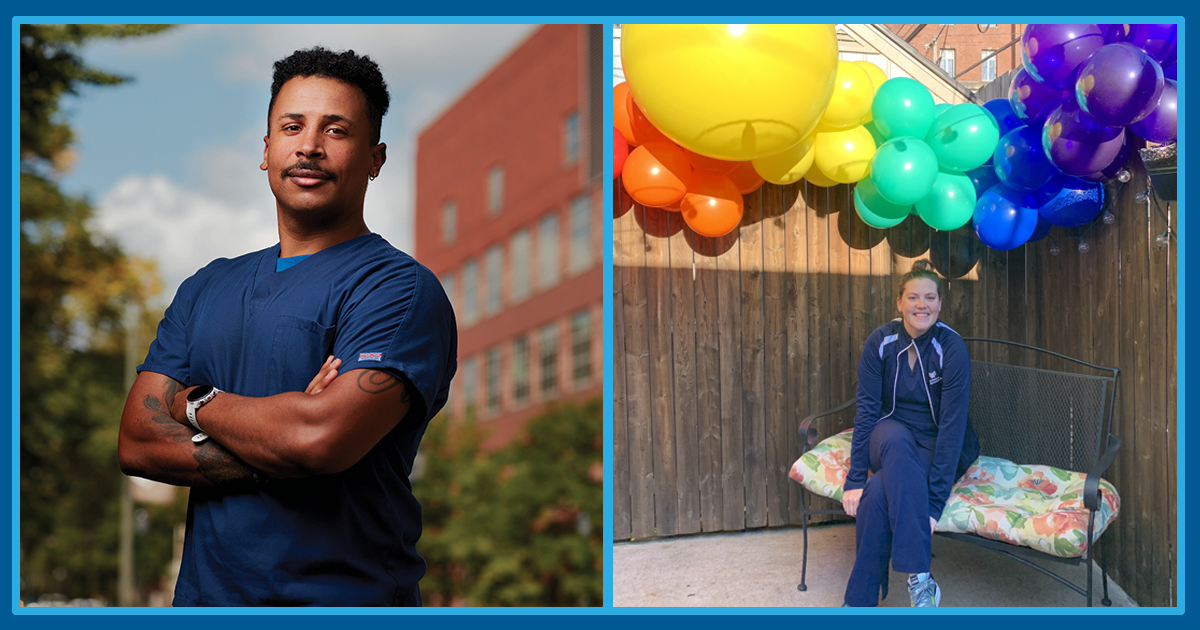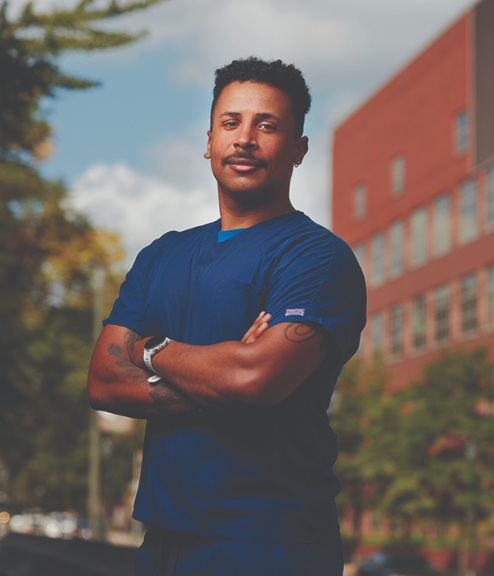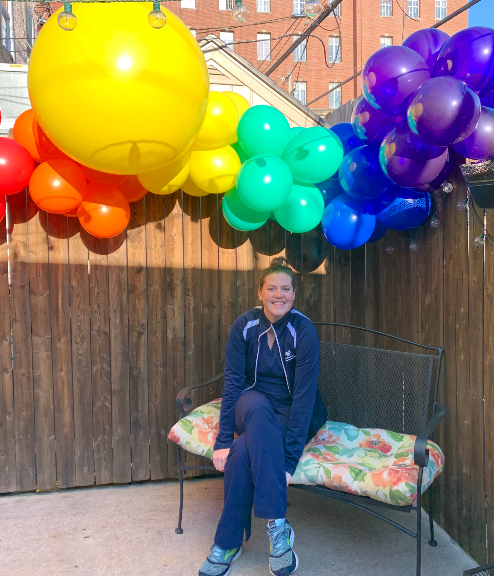

Photograph by Matt Carr
Anthony Carney ’11 outside at the Hospital of the University of Pennsylvania
where he is a nurse.
Saving Lives
Nurses Anthony Carney ’11 and Lauren Gober ’12 put their lives at risk to save others, adapting to unprecedented changes in nursing protocol and administering every conceivable treatment to cure their patients of COVID.
By Claire Kowalchik
Think to those times you’ve watched a storm move in: deep-grey clouds billowing in the distance, moving seemingly slowly, closer. Now overhead. At first, plops of big raindrops. Then the downpour. It is analogous to the arrival of COVID at hospitals throughout the country.
“We were hearing reports in early January,” says Anthony Carney ’11, a nurse at the Hospital of the University of Pennsylvania (HUP). “The country as a whole seemed unbothered by it, but we started getting prepped, having meetings, discussing what might happen and how we would handle it.” Later that month, their patient zero arrived and then a few more infected individuals showed up. “It started slowly,” says Carney, “then—out of nowhere it seemed—there was a rush of COVID patients. It was exponential.”
Lauren Gober ’12, a nurse at the Lankenau Medical Center outside Philadelphia, witnessed the same progression. “We saw one or two COVID patients at first; then our ICU units filled up,” she says. “In nursing school, you learn about viruses and plagues in history, but you never think it’s going to happen.”
Battling the Unknown
In a storm, we know what to do, where to take shelter and stay safe. But COVID was, and still is, a new threat, unlike anything we’ve ever seen. And as it poured down on us and continues to spread through the population, we struggle to treat patients and keep our communities safe.
COVID first attacks the respiratory system, depriving patients of oxygen. “In a healthy person, blood oxygen levels range from 92 to 100 percent. In COVID patients, we were seeing levels drop to 80 to 70 percent, creating a need for oxygen therapy or intubation,” Gober explains. As respiratory status declines, cardiac issues develop—heart rate and blood pressure rise—and if the disease cannot be contained, kidneys fail and other systems in the body begin to shut down.
“Some patients were beginning to have blood-clotting disorders causing pulmonary embolisms and deep vein thrombosis, which required vascular surgery or heparin therapy [heparin is a medicine used to prevent blood clots],” says Gober. “This is a new virus. In the beginning we didn’t know what other organs it would affect or symptoms it would cause. We didn’t know which medications would work; we used hydroxychloroquine and remdesivir when appropriate in combination with steroids and plasma infusions. Each COVID patient presented with varying symptoms, and we constantly were adjusting the treatment plan.”
“In nursing school, you learn about viruses and plagues in history,
but you never think it’s going to happen.” —Lauren Gober ’12
At HUP, Carney grappled with the same horrors. “We had to perform at a high level, and we were scrambling to keep up with a disease we knew nothing about. We tried all the new therapies: hydroxychloroquine, other medicines, plasma—and we didn’t see a difference,” he says. “The tried-and-true medical practices, the interventions we use with respiratory patients, worked the best. Unfortunately, we won’t have concrete answers about how to treat this disease until it’s over; that’s the way science is.”
When noninvasive measures for respiratory support failed, patients were intubated and moved into intensive care. The very sick rarely leave, says Gober. “One night, we lost three patients within three minutes. It was so awful. We all just sobbed.” But seemingly miraculous recoveries do occur. Gober recalls two patients who were in the ICU for a month and “made it out.” They were released to Gober’s unit, recovered there, and went home.
Carney tells the story of a patient who was not getting enough oxygen despite being intubated. In such severe cases, the patient is given a paralytic and positioned face down, which can increase oxygenation. “Four days later, the patient was better,” Carney says. “It was a bizarre turnaround for someone so sick.”

Lauren
Gober ’12
sits under a balloon arch, created by a Philadelphia
balloon artist who honored healthcare providers
in Gober’s neighborhood
with rainbow balloons.
Nursing Upended
COVID crashed our world, and it turned nursing protocols upside down. Policies changed constantly. Patient care has always been the priority, but the contagiousness of a disease with no cure put the safety of nurses first. Before entering a COVID patient’s room, a nurse must put on a gown, gloves, goggles, and an N95 mask or Powered Air-Purifying Respirator (PAPR, a helmet-like face shield that blows air filtered through cartridges into the breathing space of the wearer).
Training in donning and doffing taught them how to put on and take off all of this personal protective equipment (PPE) properly so as to prevent exposure to the virus. “Then there was concern that the virus could be transmitted through your hair, so we ordered surgical caps,” says Gober.
“Putting ourselves before our patients goes against everything we were taught,” says Carney. “For example, in a Code Red situation, normally everyone rushes to the patient, but in the case of someone with COVID, we all had to take the time to get dressed first.”
Changes in care were also mandated. Nurses were to minimize their time in rooms with COVID patients, which meant visiting infrequently and spending as little time as possible in a room. It required an extra level of forethought, organization, and efficiency to take everything needed for patient treatment and comfort into a room and then to capture all of the information about the patient’s status before leaving the room to share that data with the whole team of healthcare providers.
“We were treating a variety of supersick patients with different protocols,” says Carney. “You had to be diligent and vigilant.”
Under typical circumstances, patients sometimes need to be shifted in their beds for comfort or to prevent sores, but COVID patients with low oxygenation levels couldn’t be moved, because doing so would force them to use more oxygen, which could trigger cardiac arrest, Carney explains.
“It was difficult to adjust to these changes in patient care,” says Carney. “Any critical care nurse is hypersensitive. We care about patients and want everything to be perfect.”
The no-visitor policy, though necessary, resulted in the most imperfect emotional care. “Every room in the COVID unit is a single. The patients were alone,” says Gober. “Sometimes you went in just to hold their hand or hold their phone while they FaceTimed with family.”
The no-visitor policy also meant that Gober and Carney would connect dying patients with family over the phone. One such experience sticks with Carney. “A gentleman came in with his wife who was sick with COVID. She passed away, and a week later he was admitted to the hospital. He was one of the nicest people I had ever met,” Carney says. “As he lay dying, I went into the room and called his family for him. Listening to a family say goodbye, sharing memories and wishing they were together ... it was the saddest, most humbling experience I’ve ever had.”
“We had to perform at a high level, and we were scrambling
to keep up with a disease we knew nothing about.”
—Anthony Carney ’11
It’s What You Do
When Gober was 5, she came down with the chicken pox and stayed at Milton S. Hershey Medical Center for a month. “The nurses were always there to talk to and play with. They were so caring, and that’s when I knew I wanted to be a nurse.”
Carney graduated from Moravian College with a degree in accounting, but in the year following graduation, he decided to pursue a degree in nursing. “I had an organic altruism that I wanted to capture,” he says. “I wanted to help people.”
Carney describes the peak months of COVID spread, from March to June, as being overwhelming—“long days rushing your tail for 12 hours with very sick patients.” It was constant, echoes Gober—mentally and emotionally exhausting. “It was the most stressful and terrifying time of my life,” she says. “But this is what you are about. This is what you do. You take care of these patients, and you put on a brave face, for yourself and for the families. It feels really good to be there for someone. Even the littlest things, a patient will appreciate, and it means the world.”
Once the number of COVID patients dwindled at HUP and Lankenau, Carney returned to his role in the critical care float pool and Gober is back in her pre-COVID position in the surgical stepdown unit, but both are ready and willing to return to the frontlines of COVID patient care if and when they are needed.
It’s what they do.
Claire Kowalchik is editor of Moravian College Magazine.
Note: As of mid-October, Lankenau Medical Center had seen a small rise in patients. “I think COVID is going to continue to rise and fall, especially during flu season and as the cold weather moves social interactions inside,” says Gober. “I hope people rethink their large family gatherings during this holiday season and remember to continue wearing masks and social distancing when possible!”
